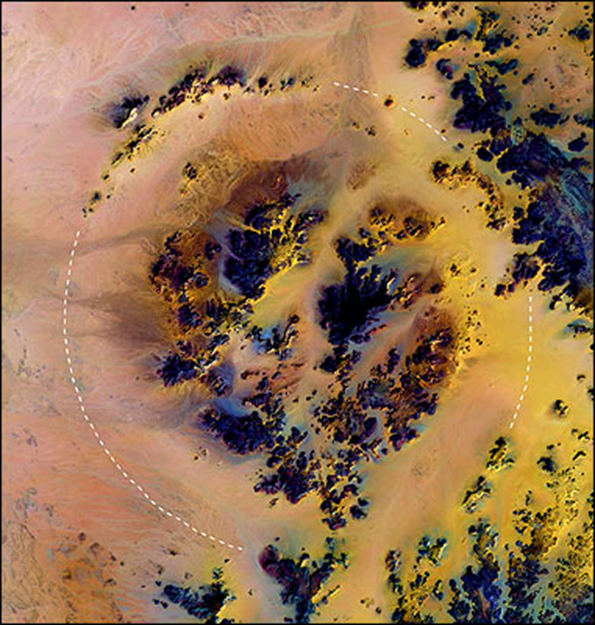Evidence for Impacts
Impact craters
- Breccia (shocked & unshocked)
- Impact Melt
- Impact Ejecta
- Fractured Bedrock

image from: NASA's Impact Crater Diagram
 |
 |
| Landsat image of Kebira Crater in Egypt's western desert, near the border with Libya. (Image: Boston University Center for Remote Sensing)
|
Manicouagan Crater , Canada (65 km diameter) source |
 |
 |
| Landsat 4 satellite image showing the lighter material thrown out of Barringer Meteor Crater, AZ, on impact. Source | Meteor Crater, Arizona (1.2 km diameter) source |
So, where are impact craters found? The map below shows the location of known impact sites. Most of them appear to be in the northern hemisphere, but that is misleading. Erosion, deposition, and ground cover can hide impact craters. Thus there are probably more sites that we just haven't found yet. The map below is from the Terrestrial Impact Craters and Their Environments website. It is an interactive map where the user can click on a dot to learn more about that impact site.

How often do impact events occur? Well, that kind of depends. Every day Earth is bombarded by micrometeorites. As with other natural disasters, the larger the event the less often it occurs.
Below is a geologic time scale from the Terrestrial Impact Craters and Their Environments website. The website has more details regarding how many occur in each time-frame, but according to their site there have been 24 impact events in the last 1 million years. Stars on the scale represent mass-extinction events associated with an impact event.

Types of Ejecta
The intense temperatures and pressures associated with the impact event creates two distinct ejecta at the impact site. Tektites are brown, grey or green natural glass formed the impact event. They range in size from dust sized (microtektites) to gravel sized.The impact can also change the minerals already present. Quartz is an extremely durable mineral. During impact events the pressure deformes the crystalline structure of the mineral along internal planes (called planar deformation features). The deformation is visible only using a microscope.
| Tektites | Shocked Quartz |
 |
 |
Sometimes the intense heat and pressure can create things of beauty. Libyan Desert Glass formed about 26 million years ago due to an impact event. The origins are still being debated - impact melt ejecta vs. melting of the desert sand. Either way, the glass is very beautiful and was knapped for tools by early humans and later made into jewelry.
 |
 |
| Above: "Libyan Desert Glass, a impact glass found in the Great Sand Sea of the Libyan-Egyptian Libyan Desert along the border. This specimen weights 22 grams and is about 55 mm wide." source: wikipedia.org Right: "Tutankhamun's pectoral features a scarab carved from desert glass" source: wikipedia.org |
Iridium is an element that is very common in meteors, but not in the Earth's crust. In the 1980s a scientist named Luis Alvarez discovered an Iridium anomaly in strata dated to 65 million years. This event is now called the Cretaceous-Tertiary event or the K-T extinction boundary as it coincides with the dinosaur extinction.
<< back |
||
